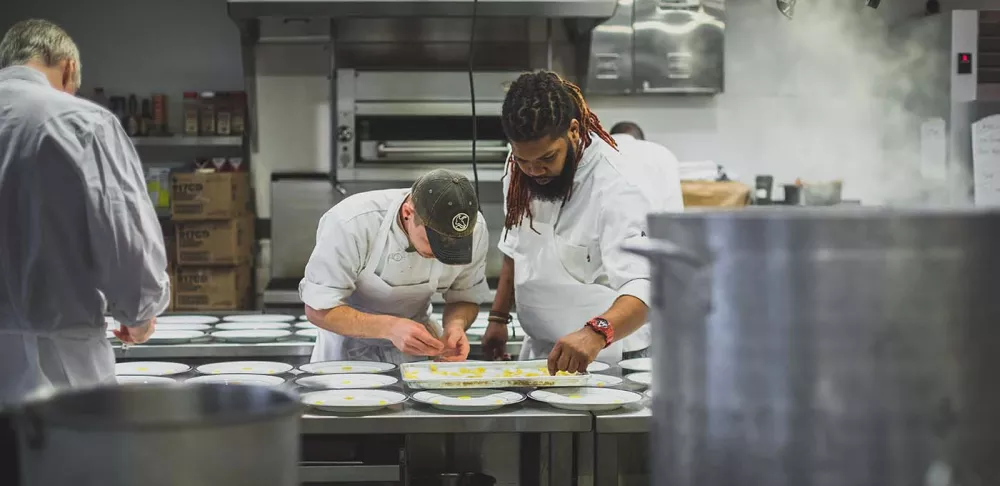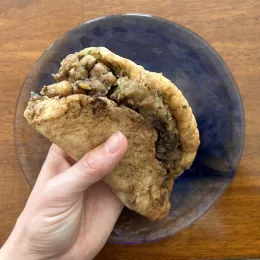As with any industry, restaurants and kitchens use unique language to communicate quickly and efficiently to keep up with the pace of service.
The hands-on career training programs at ICE end with an externship, an opportunity for students to gain experience in a professional environment while making connections to kick-start their careers. Students in the Culinary Arts, Pastry & Baking Arts, Plant-Based Culinary Arts and Hotel & Hospitality Management choose a culinary or hospitality business that matches their interest and dive right in.
After finishing the first five modules of kitchen training in the Culinary Arts program at ICE’s New York City campus, it was time for me to start my externship. While trailing at three different restaurants was a downright terrifying experience in itself, actually starting work was even scarier. I learned how to hold a knife, how to dice, mince and chiffonade. I could break down a chicken and sear scallops. But putting it all into practice at the pace a restaurant demands was nerve-racking.
In addition to learning technical skills at ICE, I had also become aware of the language used in kitchens that help chefs, servers and all the different people who make a restaurant work successfully, stay on the same page.
Below is a list of terms that are common in many restaurants that were helpful for me to know throughout my externship.
All day: Used to indicate how many total orders of a specific item are outstanding. For example, “Ten salads all day” means the chef needs 10 total salads regardless of which tables they are for. When I was working brunch service, orders were communicated verbally, so I would hear two salads, one bacon, one egg for one party, along with one salad, three bacon and two eggs for another.
Example:
“How many salads, Chef?”
"Three all day.”
À la carte vs. carte blanche: It’s good to be familiar with your restaurant’s menu items as well as how the menu works. Some restaurants are carte blanche, which translates from French to “blank check,” in which the diners don’t pick their meal — the chef has the freedom to serve what they’d like. As opposed to à la carte, where diners order each dish individually.
Back-of-house (BOH) vs. front-of-house (FOH): Back-of-house refers to the people and parts of the restaurant that the guests don’t see, and front-of-house is the opposite. BOH spaces include food storage, prep space, kitchens and offices, and the people encompass chefs and dishwashers. FOH areas refer to the entrance, dining room, restrooms, etc., and the people who work in those spaces: the general manager, host, servers, runners, bartenders, bussers and beyond.
Corner: An obvious, but important one, “corner” is spoken assertively to communicate when you’re turning a corner so you can avoid knocking into someone coming from the opposite direction. In the same vein, we’d also say “up” or “down” when using the staircase in the restaurant I worked at. It should go unsaid that you may be carrying precious mise en place, rushing to get more herbs or face an incoming server balancing plates.
86: Used to describe when a restaurant runs out of a specific ingredient or dish and is typically communicated from the kitchen to the front-of-house to remove the item from the menu. “Eighty-six the scallops.”
Family meal: A meal for front- and back-of-house to eat before service begins. All other factors vary by restaurant, including who cooks the meal, the amount of time and care put into it, where the staff eats and what times of day it takes place. Luckily at the restaurant I worked at, the family meals were delicious, nutritious and filling — I looked forward to them. For me, this was a great time to get to know my colleagues, rest my feet and decompress before service started. However, if you’re behind on prep, you’ll be shoveling in dinner so you can race back to the kitchen. “Family’s up!”
Fire ___: Called out by the Chef to let the line cooks know it’s time to make a dish: “Fire salmon!”
Hands: Said when dishes are ready to be picked up, typically from the pass or kitchen so the servers and runners can bring them to the table. “I need hands!” Or, “Hands, please.”
In the weeds/going under: When a station falls behind and fails to complete orders in a timely manner. Don’t worry, everyone experiences this at some point. Maybe you didn’t prep enough or you started to lose focus and became disorganized. Bottom line: figure out what went wrong and learn from it.
Mise en place: This French phrase translates to “everything in its place,” and represents an essential pillar of working in a kitchen: staying organized and being prepared. “Mise” is typically used to describe having the ingredients of a recipe measured out, prepped, stored and labeled correctly in advance, but it also extends to a chef’s knives, equipment, notebooks, Sharpies and pens. According to Lead Chef & Operations Manager Joshua Resnick, “Keeping your mise clean and organized allows for a smooth flow and sense of calm knowing where something is going to be. Not having to look for every single item and just using muscle memory can be a huge weight off one’s shoulders in the kitchen.”
On the line: Congratulations! You’ve graduated from the prep team and are now a line cook working for service.
On deck: A phase called by the expeditor to signal upcoming orders so the stations can start preparing them. “Two scallops on deck.”
The pass: This is where plates go for a final garnish or inspection before they're sent to the dining room. It’s also where components of a dish that are prepped at different stations meet to be plated together. In restaurants with open kitchens, you can usually see where the pass separates the kitchen from the dining room. The pass is typically run by the expo (or expeditor) who calls out the orders on each ticket. In the restaurant I worked at, this station was run by the Chef or Chef de Cuisine.
Heavy/Hot/Sharp/Behind: Used to caution others that you are carrying something heavy, hot or sharp (knives). All can be combined with “behind,” warning you that someone is moving behind you.
Yes, Chef: Added to common vernacular by "The Bear," “Yes, Chef” is used as an affirmation. If a Chef is demonstrating how they’d like you to prepare omelet kits, you say “Yes, Chef” to show you understand. When the expeditor calls out the orders on the ticket, you say “Yes, Chef” so they know you’re aware. Synonymous with “oui” (“yes” in French) and “heard.” To note, at the restaurant I externed at, “Chef” was used as a sign of respect and everyone was considered a chef (dishwasher, bartender, chef de cuisine, etc). I’ll never forget the first time someone called me “Chef Cory.”
It’s important to note that while the above definitions are mostly unanimous in the industry, all restaurants are operated differently and may have their own lingo based on their systems, facility and people.






